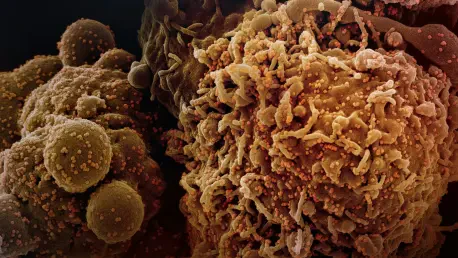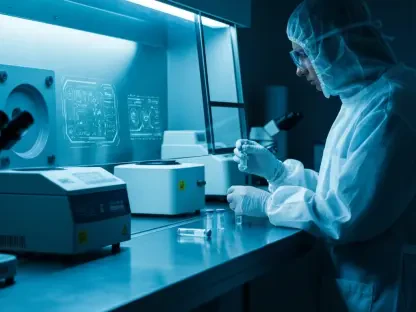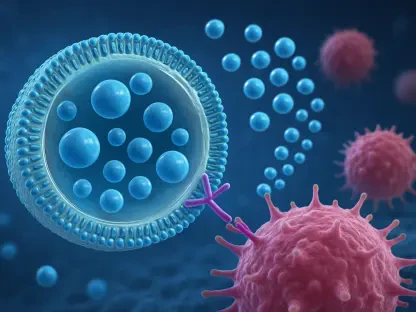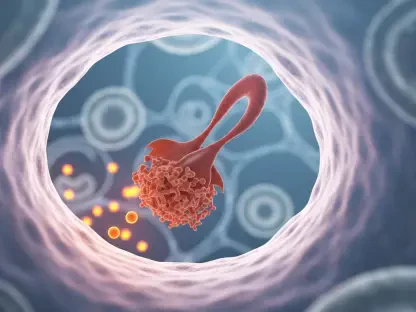Recent research spearheaded by the University of California, San Diego, alongside international collaborators, has uncovered a potentially vital link between the bacterial toxin colibactin and rising colorectal cancer cases among individuals under the age of 50. Published in Nature, the study suggests that early-life exposure to colibactin may play a significant role in this concerning trend. Colorectal cancer, traditionally associated with older adults, is now increasingly diagnosed in younger populations, raising pivotal concerns regarding its etiology and prevention strategies. This research provides an opportunity to delve deeper into the factors influencing this surge and the potential preventive measures that could be crucial in addressing this public health issue.
The Role of Colibactin
Understanding Colibactin
Colibactin, produced by certain strains of Escherichia coli, is at the forefront of this investigative effort due to its capability to alter DNA within colon cells. Found prevalently in the human gastrointestinal tract, this toxin’s potential to induce mutagenic changes raises alarms about its long-term impacts on human health. Unlike typical bacterial toxins, colibactin has a unique affinity for creating double-strand DNA breaks, leading to mutations that, over time, might culminate in cancerous growths. The study underscores the biological complexity of colibactin, which continues to challenge researchers aiming to comprehend its broader implications. Furthermore, understanding how colibactin is acquired in early childhood and its persistence in the gut could pave the way for future research initiatives.
The research highlights the intricate relationship between colibactin and DNA mutations, offering insights into how these alterations, specially induced by bacterial activity, differ from those caused by other known carcinogens. Colibactin’s role as a natural yet potentially dangerous entity in the gut presents a significant scientific puzzle, prompting questions about its contribution to colorectal cancer development and, more importantly, how it could be mitigated. By exploring the biochemical pathways through which colibactin influences host DNA, scientists aim to identify key intervention points that could prevent or repair these mutations, thereby reducing cancer risk.
Genetic Footprints
The study’s analysis of nearly 1,000 colorectal cancer genomes from patients under 50 reveals a clear pattern of mutational signatures associated with colibactin. These signatures are significantly more prevalent among younger patients, supporting the hypothesis that early-life colibactin exposure is a contributing factor to early cancer onset. This discovery is crucial as it provides a genetic “fingerprint” that could serve as a diagnostic tool, enabling early detection and intervention. By tracing these molecular signatures, researchers hope to establish a definitive causal link between colibactin exposure and the emergence of colorectal cancer, potentially transforming how this disease is diagnosed and treated.
In-depth computational analysis sheds light on the distinctive genetic marks colibactin leaves behind, broadening the understanding of its mutagenic potential. This genomic imprinting serves as a historical record within the DNA, chronicling exposure and possibly elucidating the timeline of carcinogenic processes initiated by colibactin. The development of methods to detect these specific genetic alterations could provide critical insights into the timeline of disease progression, emphasizing the need for strategies targeting early exposure phases. Such an approach could revolutionize preventive measures, redirecting efforts toward minimizing early-life colibactin contact.
Alarming Trends and Insights
Increasing Incidence
The rising incidence of colorectal cancer among younger populations presents a disturbing trend, indicating a shift in the age distribution of this once predominantly age-related disease. Projections suggest that should current patterns persist, colorectal cancer could emerge as the leading cause of cancer-related deaths among young adults by the end of the decade. This scenario presents a daunting challenge for public health officials and researchers, necessitating a thorough investigation into potential underlying causes. The data capturing this demographic transition underscores the urgency in addressing environmental and microbial factors contributing to this surge, moving beyond traditional risk assessments anchored in age, genetics, or lifestyle.
This increase is particularly concerning because younger individuals diagnosed with colorectal cancer often fall outside typical risk profiles. Lacking common risk factors such as family history, obesity, or hypertension, these cases prompt a reevaluation of existing cancer screening and prevention frameworks. The inadequacy of current paradigms to account for the rise in incidence among young adults highlights a gap in understanding and points to the need for innovative research approaches. Pinpointing microbial or environmental influencers, such as colibactin, could significantly refine preventive strategies, offering a targeted approach based on emerging evidence rather than traditional metrics alone.
Lack of Traditional Risk Factors
The absence of conventional risk factors in younger colorectal cancer patients suggests alternative pathways leading to the disease, with microbial involvement, specifically colibactin, gaining increasing attention. This unexpected demographic, often devoid of family history or prevalent health conditions like hypertension or obesity, challenges existing oncological paradigms. The exploration of alternative pathways pivots researchers’ focus to environmental carcinogens, lifestyle changes, and microbial roles, inviting a more comprehensive risk assessment and management strategy. Recognizing colibactin’s impact as a potential disruptor of cellular integrity invites a broader understanding of cancer etiology beyond genetic predisposition.
Emerging research advocates for a closer examination of the gut microbiome’s role in health and disease, providing crucial insights into how toxins like colibactin could silently undermine youthful health. This perspective endorses a paradigm shift in cancer research, urging scientists and medical professionals to consider multifactorial influences in disease causation. With potentially life-altering implications, investigating microbial contributions requires multidisciplinary collaboration, fostering an integrative approach that aligns with modern medical practices aiming to mitigate these newfound risks. Consequently, refining cancer detection and treatment frameworks to accommodate these findings could significantly reduce incidence rates through proactive measures.
Global Implications and Research
Geographic Variations
The prevalence of certain mutational signatures associated with colibactin differs globally, with notable concentrations in countries like Argentina, Brazil, and Thailand. These geographic variations prompt further examination of environmental or lifestyle factors unique to these regions that might contribute to higher exposure rates. Understanding these variations is vital for developing tailored public health strategies that address region-specific risk factors, moving toward a more personalized approach to cancer prevention. As mutational landscapes differ, insights gleaned from such analyses could inform policy decisions, educational campaigns, and localized intervention strategies, impacting global health outcomes.
Researchers exploring geographic disparities aim to uncover factors contributing to colibactin exposure, recognizing that these environmental influences could extend beyond borders, affecting diverse populations. The interplay between local diets, lifestyle choices, and microbial presence necessitates a comprehensive analysis, through which meaningful connections can be established. Such investigations also provide cross-cultural insights, encouraging international collaboration and knowledge exchange that can refine localized interventions. This holistic approach ensures consideration of global health perspectives, balancing scientific rigor with cultural sensitivities, which is vital for successfully curbing cancer incidence worldwide.
The Mutographs of Cancer Initiative
The Putative Mutographs of Cancer Initiative is a comprehensive global effort designed to map the environmental causes of cancer, with projects like this one highlighting bacterial toxins’ role in shaping cancer risk profiles. By identifying mutational patterns specific to environmental carcinogens, such as colibactin, the initiative seeks to build a detailed catalog of genetic changes associated with various agents, ultimately informing prevention and intervention strategies. This forward-thinking approach aims to elucidate the intricate connections between environmental exposures in early life and later cancer development, providing insights that can shape future research and public health initiatives.
Through the lens of the Mutographs of Cancer initiative, researchers are positioned to explore the intersection of microbial biology and oncology, harnessing technological advancements in genome sequencing to refine their understanding of cancer’s environmental roots. By correlating the timing and nature of mutational events with specific carcinogenic exposures, this initiative advances a growing body of work integrating multiple disciplines. International in scope, the Mutographs project fosters collaboration, emphasizing the importance of sharing and synthesizing data to combat cancer collectively. As the initiative progresses, its findings hold the potential to transform cancer prevention strategies, offering region-specific insights that could drastically alter treatment paradigms.
Developing Preventive Strategies
Potential Prevention Measures
As insights into colibactin’s role in colorectal cancer development grow, so does the emphasis on devising preventive measures that can curtail its impact. Strategies such as probiotics aimed at reducing harmful bacterial strains, or early detection tests for colibactin-related mutations in stool samples, are under examination. These measures hold promise in mitigating the toxin’s influence, potentially lowering cancer incidence through proactive intervention. The development of such strategies is rooted in understanding the lifecycle of colibactin-producing bacteria and targeting them effectively, combining scientific findings with practical applications for disease prevention.
Innovative approaches to prevention must be flexible, acknowledging the complexity of microbial ecosystems and the nuanced interactions between human hosts and their resident bacteria. By advancing screening technologies to detect colibactin’s genetic signatures early on, healthcare systems can prioritize preventive care tailored to individual risk profiles. This shift toward a predictive and preventive healthcare model highlights the importance of integrating cutting-edge research into routine medical practice. Efforts to channel this knowledge into actionable interventions could substantially impact colorectal cancer statistics, paving the way for a future where incidence rates are managed through strategic, evidence-based initiatives.
The Path Forward
A recent study led by the University of California, San Diego, in collaboration with international researchers, has shown an important link between colibactin, a bacterial toxin, and the increasing number of colorectal cancer cases in people under 50. The study, published in the journal Nature, indicates that being exposed to colibactin early in life might be a major factor in this worrying trend. Colorectal cancer has typically been associated with older adults, but now, it is being diagnosed more often in younger people. This shift raises serious questions about the causes of the disease and how it can be prevented. This research opens the door to a better understanding of the elements contributing to the rising cases and highlights the need for developing effective prevention strategies. Such preventive measures could be essential in tackling this growing public health challenge, offering hope for reducing the incidence of this disease in younger populations by targeting its root causes.









